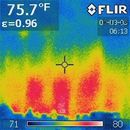Fiberglass Batt Performance (Infrared image)
Inspecting a home with high bills yesterday and I saw something with my infrared camera that I do not recall seeing before.
Picture Details: East Wall from the interior, approximately 10:30 AM (disregard time stamp in the image, it is incorrect) Inside Temp 72, outside temp 84 degrees. The cooler section at the top is shaded by the eaves, warmer section in full sun. Medium Brown color on exterior.
Wall Details: 2×4, R-13 (Confirmed by drilling hole), House-wrap and Smart-Side
Typically I see the studs and edges of the batt insulation to be warmer than the center of the cavity.
Any thoughts as to what is happening here?
GBA Detail Library
A collection of one thousand construction details organized by climate and house part










Replies
I think it would help understand if you do a PIP or a fusion of optical and thermal images for clarity. I don't own a FLIR, but with a HIKMICRO we can do that.
I do have a PIP of the same area, but I did not think there would be much value there as it is a basically empty wall with only a headboard against it.
Deleted
I would interpret that picture as having insulation missing in that spot or badly installed insulation. Many times I see fallen insulation that drywallers fail to install again.
Usually what I see is mostly a batt insulated wall with no top plate and corner air sealing, and a double stud supporting a beam (76° Indoor/108°Outdoor)
jdclassen,
I agree with Armando that poor installation is a good first choice to consider. My reading of the FLIR was to at first suspect the insulation batts were set tab in - on the sides of the studs, which leaves gaps behind the drywall. The shadowing from the eaves shows the wall temperature to be pretty even. That suggests the batts are set pretty well. If set poorly I would expect heated air to rise in the gap behind the drywall a bit more randomly. Even Armando's FLIR example shows the stud material being far in excess of the insulation. It is still possible that the middle batts are short in the bay at the bottom or duct work is placed in those bays, but I would like to propose another thought.
It might be instructive to re-take the FLIR image a few hours later to see if the differences "even up" or reverse. The shaded top portion of the wall is escaping the heat load shift and reads a bit more like "normal". The blue color seems to match the stated 72F interior temperature noted. The scale shown suggests that the stud to center of bay temp difference is about 2 degrees. The image also suggests that the left and right most bays are not nearly as deviant from the stud temperature being recorded. If the wall is in full sun is there any surface outside that could be bouncing extra solar energy at that one section. A white concrete walkway perhaps? Or is it a camera artifact?
It would be helpful to know if A/C was on in the home prior to this FLIR image being taken and for how long. The apparent temp difference might be due to the studs cooling more than the batts overnight if the side bay differences are in deed a camera artifact. The ~R-5 studs having slightly higher losses to the outside than the (hopefully) R-13 batts. The overnight dead air trapped in the batts might be staying warmer longer than the studs simply because the batts have greater resistance to heat flow back out. Outside overnight air temps will play a large part in how this works out. The A/C selectively chilling the studs a bit before the sun comes up creates a larger temperature gradient to over come before they finally warm up enough to record as expected. ie. hotter than the center of bay.
It could be argued that the heat transfer inward of the studs would swamp the A/C effect because the studs are lower R than the batts, but you might be recording a transition point that only occurs in the morning. The studs having "cooled" a bit lower than the batts will take a bit longer to match or exceed the batts higher steady state.
A similar effect of "hot soaked insulation" occurs in attic insulation where the static air in the insulation layer gets very warm far deeper than one expects. Rummaging around looking for buried electrical boxes has taught me this. While the ceiling drywall is usually cool to touch, the insulation above is not. It should be expected, as the attics I have had the joy of being in were often 120F or more. The many types of venting encountered seem only to have saved me from be fast broiled. One home had concrete tile roofing, so there was a huge mass keeping the attic hot pretty much overnight. Arriving early to do work in the attic was not much relief from four in the afternoon. The insulation was still warm (and itchy) to touch.
It might be fun to have time lapse FLIR with a high sensitivity camera.
Since it's the bottom of the wall I would guess wet insulation.